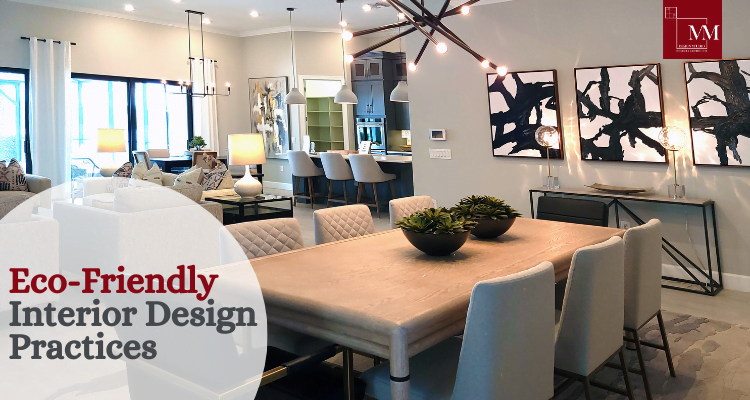Eco-Friendly Interior Design Practices for Delhi Homes

Adopting eco-friendly interior design emerges as a sustainable ethos manifesting responsible resource utilization and waste reduction as environmental consciousness grows in Delhi households.
In this blog, we’ll share helpful tips for practical home implementation along with an explanation of the concept of eco-interiors and the advantages of using green materials and appliances for indoor air quality and conservation.
Through thoughtful interior design, creative integration enables inhabitants to maintain ecological integrity whether building new spaces or renovating old ones.
Definition of Eco-Friendly Interior Design
In order to minimize resource depletion and carbon footprints, eco-friendly interior design refers to the deliberate creation of built environments that use renewable, ethically harvested materials along with efficient construction techniques.
Furthermore, to green finishes that improve indoor air quality and biomimetic ideas that mimic the patterns found in nature, highlight ethical material sourcing.
An environmentally conscious home incorporates non-toxic paints, repurposed wood, and air-purifying plants into its design while keeping in mind the comfort and health of its occupants. Eco-interiors align human-centered as well as environmental values.
Growing Importance of Sustainability in Delhi Homes
- Delhi’s fast urban growth has put an excessive strain on public resources like electricity and water, making conservation measures in homes necessary.
- In order to reduce health risks, there is a growing need for indoor plants that purify the air and air filters.
- Interior design that is environmentally conscious is being driven by a growing public awareness of environmental issues.
- Adoption is accelerated by government building incentives such as expedited plan approvals and increased floor area ratios for projects with a green rating.
- The market expansion for eco-friendly materials and appliances has simplified and reduced the cost of obtaining recycled wood, paints free of toxins, LED lighting, and energy-efficient fixtures.
- Residents of Delhi strive to demonstrate their commitment to sustainability by making eco-conscious decisions on a daily basis, extending to interior design and aesthetics. Sustainability is becoming increasingly embedded as a fundamental lifestyle ethos.
These indicate that the incorporation of sustainability is increasingly crucial for Delhi households, as it shapes not only the infrastructure but also the general attitudes and quality of life in a city that is growing quickly.
Benefits of Eco-Friendly Interior Design
- Using sustainable materials like bamboo flooring and toxin-free paints that allow for clean, fresh air circulation results in healthier indoor living. Better air quality for increased wellbeing is made possible by this.
- Energy-saving appliances, solar photovoltaic panels, and automated lighting are examples of fixtures that can reduce energy use and ultimately electricity costs.
- The installation of sensors, dual-flush systems and many other recycled water alternatives reduces the use of this natural resource while also refilling depleted reserves.
- Reclaimed wood and other upcycled, ethically harvested furnishings contribute to the decrease of waste as their production avoids further depletion of resources.
- When spaces incorporate decisions that are sustainability-driven such as indoor gardens and rainwater harvesting, their lower lifecycle footprints indicate your commitment to the environmental awareness for future progress

Choosing Sustainable Materials
When choosing materials, choose preserved or recycled options such as wood, tile, and metals, which have reduced carbon footprints. Choose organic and natural fiber textiles such as cotton, wool, jute, and silk that are biodegradable and non-toxic.
Avoid using plastics and synthetics, as they consume resources and pollute. Certifications such as FSC, Greenguard, and Green Label imply sustainability. Prioritise locally obtained materials to reduce transportation-related emissions.
Importance of Energy-efficient Lighting
The best interior design company recommends using energy-efficient LED lighting, which uses up to 90% less electricity than traditional solutions. They expertly maximize natural light with intelligent window design and placement. Sophisticated dimmers, occupancy sensors, and timers further reduce energy consumption.
Erudite designers may add sophisticated smart lighting systems that automatically adjust brightness and temperature for maximum efficiency.
Such lighting knowledge from renowned interior designers reduces environmental impact while creating healthier, more visually appealing living areas.
Smart Choices for Eco-friendly Appliances
The focus of the eco-friendly interior design is on using energy and water saving appliances that have a high Energy Star rating. Focus on the energy-saving functions like sensors and also automatic sleep mode. Select the appliances of sufficient sizes to prevent overconsumption.
Seek such eco-labels as WaterSense to reduce the water. Prefer natural refrigerants over the chemical ones. Proper appliance selection minimizes the utility consumption and also ensures the required functionality to fit in with eco concepts for the interior design.

Indoor Air Quality Improvement
To improve indoor air quality, eco-friendly interior designers propose adequate ventilation, air-purifying plants, and low VOC materials. The strategic positioning of air vents and fans promotes air circulation.
Opening windows on a regular basis can also assist. It is preferred to use materials such as wood, stone, and glass that emit minimal levels of volatile organic compounds.
Plants such as aloe vera, ivy, and ferns filter interior pollution. Such solutions promote healthier indoor conditions and correspond with eco-friendly interior design ideas.
Implementing a Waste Management Plan
Architect in Delhi promote household waste management by recycling, composting food scraps, and eliminating single-use plastics. Use separate bins for recyclables, compost, and landfill waste.
Consider scrap upcycling when renovating. Hire rubbish collection services to appropriately manage e-waste and hazardous products. Such planning decreases waste to landfill and the carbon footprint. Architects advocate it as an essential component of environmentally sustainable architecture.
Efficient Plumbing Fixtures for Water Conservation
Eco-friendly interior designers emphasize the use of water-saving plumbing equipment. Low-flow faucets and showerheads save water while maintaining pressure. Dual-flush toilets utilize less water per flush.
Water-efficient washing machines as well as dishwashers are also recommended. Rainwater harvesting and greywater reuse technologies promote water sustainability.
Such solutions adhere to eco-friendly interior design principles that promote resource conservation through house plumbing upgrades.
Tips for Implementing Eco-Friendly Design at Home
When designing an eco-friendly interior, start by identifying your sustainability goals and priorities. Conduct an energy audit to find efficiency potential. Maximise natural light via skylights and wider windows. Install solar panels if possible. To improve heating and cooling efficiency, insulate the walls and ceiling.
Choose eco-friendly paints that contain little or no VOCs. Choose sustainable materials such as bamboo floors, wool rugs, and recycled glass countertops. Combine high-efficiency LED lights and motion sensors. Use power strips to totally turn off electronics. Install low-flow plumbing fittings.
To assist waste diversion, create specific areas for recycling, composting, and garbage. Plants can help purify indoor air. Consider environmentally friendly furniture made from sustainable wood and organic textiles. Use natural-fiber rugs and drapes. Keep improving through iterations, sustainability is a journey.
Conclusion
Environmentally sustainable homes need an eco-friendly interior design. It will be possible for Delhi`s residents to significantly reduce the carbon footprint due to the application of concepts from green materials, energy efficiency, water conservation air quality and waste management.
While it is an investment at the start, sustainable interior design techniques produce a healthier and greener living spaces and contribute to preserving nature for future people.
This environmentally conscious approach is very critical in constructing the green and also comfortable homes. For an eco-friendly interior office design, you can consider choosing MM Design Studio.
